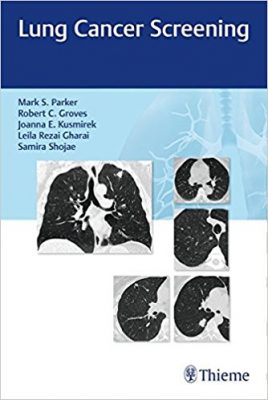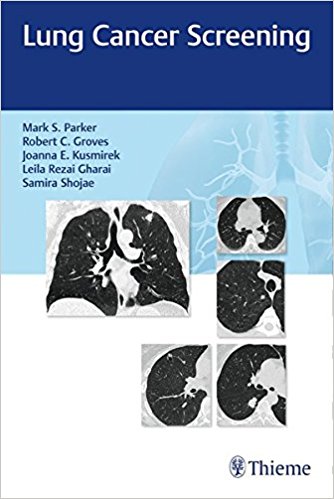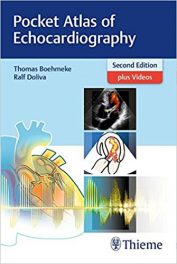 Editors: Mark S. Parker, MD; Robert C. Groves, MD; Joanna E. Kusmirek, MD; Leila Rezai Gharal, MD, and Samira Shojabee
Editors: Mark S. Parker, MD; Robert C. Groves, MD; Joanna E. Kusmirek, MD; Leila Rezai Gharal, MD, and Samira Shojabee
Publisher: Thieme – 104 pages, with 52 illustrations
Book Review by: Nano Khilnani
The facts on lung cancer are sobering. Lung cancer is not only the leading cause of cancer death among men and women in the United States, but also worldwide. Each day lung cancer kills more people in the U.S. than all other people who die from cancers of the breast, colon, liver, kidney, prostate, rectum, and skin combined.
For 2018, the estimated number of all new of U.S. cancer cases is 1,735,350, about a 2.8 percent increase from 2017. People who are estimated to die from all cancers in 2018 is 609,640: (a 35 percent mortality rate) and a 1.5 percent increase from 2017. That works out to 50,800 deaths every month.
The American Cancer Society, which has been keeping records for many years, estimates that 154,050 people in the U.S. (over a quarter of all U.S. cancer deaths) will die from lung and bronchial cancer alone – an average 422 lung cancer deaths per day, nearly 18 per hour, and three per minute.
The number of deaths from all cancers and from lung cancer increased in 2018 from the previous year. The ACC’s 2017 records show that 1,688,780 people were diagnosed with various types of cancer. Of that, 600,920 people, or about 36 percent, became victims and died of cancers in various parts of the body. This is an estimated number of deaths, and should not be compared with previous years’ deaths, the ACC cautions, as they vary from year to year.
About 85 percent of lung cancer cases are due to long-term tobacco smoking. Some 10 to 15 percent of lung cancer occurs in people who have never smoked, but have genetic and environmental factors, such as parents who smoke tobacco, exposure to second-hand smoke and asbestos, and air pollution.
Lung cancer is of two basic types: small cell carcinoma and non-small cell carcinoma. Both are metastatic diseases that spread to tissue in other parts of the body beyond the lung. Lung cancer is difficult to reverse when it is not localized, and has spread widely beyond a certain point. The common forms of treatment to alleviate pain are: chemotherapy, radiotherapy, and surgery
Nine specialists – in pulmonology including bronchoscopy, and radiology – including the five editors shown above, authored the 10 chapters of this book shown below. They are all from Virginia, including eight affiliated with Virginia Commonwealth University (VCU) Health.
- Lung Cancer Epidemiology
- Risk Factors for Lung Cancer
- Evolution of Lung Cancer Screening
- Lung Cancer Screening Pros and Cons
- Variable Imaging Presentations of Lung Cancer
- Lung Cancer-Screening Results Reporting
- Detection, Management of Unexpected Incidental Pulmonary and Nonpulmonary Findings
- Elements of a Successful Lung Cancer-Screening Program
- Future of Lung Cancer Screening
- Test Cases: Applying Lung CT Screening Reporting and Data System (Lung-RADS
Even as lung cancer is the leading cause of cancer death in the U.S. based on data, it was the only type
of cancer among the top four (lung, breast, colorectal, and prostrate) that was not subject to routine screening. This was because “no early detection program had shown a reduction in mortality from lung cancer with sputum and/or conventional radiographic screening,” write the authors – Drs. M.J. Lee, Samira Shojabee, and Mark S. Parker – of chapter 3 – Evolution of Lung Cancer Screening. –
But in November 2011, after the results of the National Lung Screening Trial (NLST) were released, its recommendation for lung cancer screening for eligible high-risk persons was endorsed by the U.S. Preventive Services Task Force (USPSTF). Hopefully, lung cancer deaths will one day begin to come down below the numbers we cite above.
The authors cite the merits of other early detection screening programs for other cancers. For example early detection of breast cancer using mammography has resulted in a five-year survival rate of 90 percent, and screening for colorectal cancer has brought about a five-year survival rate of 64 percent.
While we briefly wrote about one chapter, useful information is available in all chapters of this important book, as gleaned from the titles of its chapters we show above.
Editors:
Mark S. Parker, MD, FACR is Professor if Diagnostic Radiology and Internal Medicine, Director of the Thoracic Imaging Division, Director of the Imaging Fellowship Program, and Director of the Lung Cancer Screening Program at Virginia Commonwealth University (VCU) Health in Richmond, Virginia.
Robert C. Groves, MD is Associate Director of the Radiology Residency Program, and Assistant Professor of Radiology in the Cardiothoracic Division of the Department of Radiology at VCU Health in Richmond, Virginia.
Joanna E. Kusmirek, MD is Assistant Professor of Radiology in the Cardiothoracic Division of the Department of Radiology at VCU Health in Richmond, Virginia.
Leila Rewzai Gharal, MD is Assistant Professor of Radiology in the Cardiothoracic Division of the Department of Radiology at VCU Health in Richmond, Virginia.
Samira Shojabee, MD is Assistant Professor of Internal Medicine and Fellowship Director of the Interventional Pulmonary Program in the Division of Pulmonary and Critical Care Medicine at VCU Health in Richmond, Virginia.
Other authors of content:
Michelle Futrell, MSN, MBA, RN
Peter M.J. Lee, MD
Avinsh Pillutla, MD
Deepankar Sharma, MD







